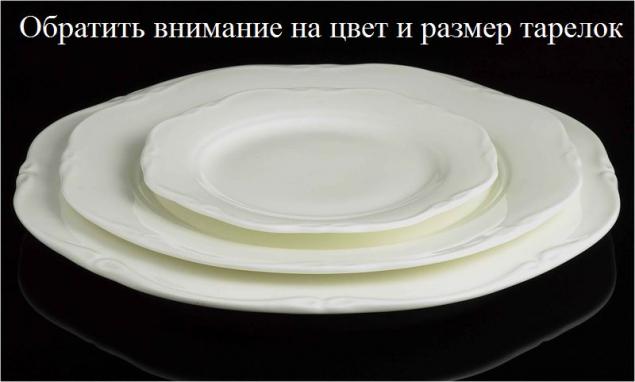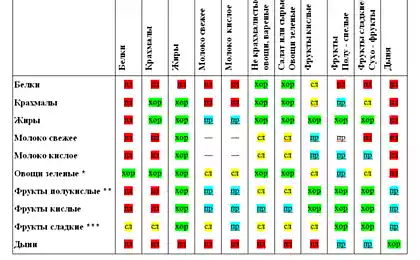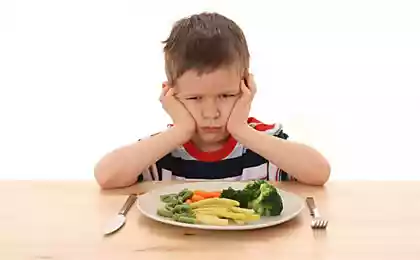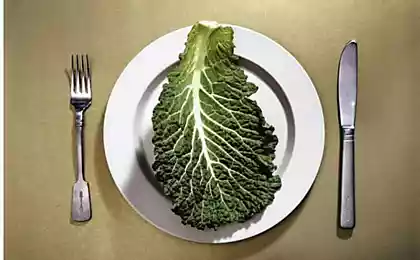1436
How to configure the brain to healthy eating (6 photos + text)
I want to introduce you to a few tricks that will help the brain adjust to a healthy diet.
Eat the right foods and stay healthy.


As strange as it may sound, using large forks, we eat less food. It's not that the hand gets tired easily wield a heavy instrument, and that is how we will achieve a feeling of fullness of the stomach.
In one experiment, the scientists within a few days went to the restaurant at random giving the visitors the different types of plugs. Half of the visitors were given a plug 20 percent larger than average size, and the other half - 20 percent less, and then was measured amount of food left on the plate.
It turned out that people, eat with the large forks, left more food than those who used small appliances. But why the big fork make us eat less? The fact that the eye plays an important role in nutrition. We rely on visual information to control the amount of food eaten (tracking the visible remnants of food on the plate), because our nervous system gives a signal of saturation with some delay.
Therefore, if the eyes tell the brain that you ate, the brain and solve. Eating a large fork, you will snap off at a time, a significant portion of food, your eyes will see it, and the brain will think if you overeat. At the same time, with a small amount of food with a fork on a plate will change gradually, so you quietly slip through the critical level, adding a little more volume to your powerful thighs.
However, the "method of a large fork" only works with regular admission food you eat to satisfy hunger. Those who like to eat to satiety, a large fork to help unless fill tighter womb.

Here's a simple trick to get rid of a few kilograms - keep close healthy food ... and do not eat it. Keep it simple with disapproval watches as you tuck into a regular pizza.
What for? It turns out that even the presence of a healthy meal on the table makes us more cautious consumers. According to a study conducted by Cornell University, the presence of healthy foods (such as fruits and salads) positively influences the choice of food, even if we do not stop at the most "correct" versions.
During the experiment, the researchers in a few days I was a school cafeteria lunch menu. One day the menu was present sweet food, such as applesauce and fruit salad, and the next day appeared healthy dishes such as green beans and bananas. Naturally, most of the students ignored the obvious attempts to get them to eat properly and to choose what is normally.
Anyway - so they thought. The researchers found that in those days, when the menu was green beans and bananas, students choose more healthy foods, unlike the days when offered sweets.
This is how the priming effect: the child was enough to remind only of the existence of a healthy food, as he immediately felt subconsciously blame poor diet and opt for healthier meals. Similarly, we are less likely to use expletives, sitting at the same table with the priest.

You may be familiar with the results of recent studies showing that diet foods are harmful, not only because of the chemistry by which, in our stomachs breed bacteria. It turned out, diet soda and other low-calorie foods make us fat, because we think that this is not so.
Labels on food is more important than one might think. In one experiment, subjects were given a cookie. Thus on the one packaging was written "average", but on the other - the "big". Eat cookies allowed any number. What's the catch? All the cookies were the same, but the people, relying primarily on the brain, rather than on intuition, ate more "average" and less "big" to protect themselves from excess calories.
But in the process it involved not only the psyche. It is a real effect and is subject to our body. Our body has a hunger hormone - ghrelin (not to be confused with the gremlins!). It ghrelin makes us eat, and the more ghrelin in the body, the more our appetite, and - on the contrary. But here's the thing. Number of ghrelin produced depends not only on the real, but the apparent amount eaten.
Researchers from Yale University gave each subject a milkshake energy value of 380 calories. Thus one half of the volunteers said that cocktail contains 620 calories, while the other half was fed as a dietary cocktail - all with 140 calories. After all the glasses were emptied, the subjects took a blood test to establish the level of ghrelin.
Laboratory tests have clearly shown: in the blood of people think that drink high-calorie drink, ghrelin levels dropped significantly, and those who (supposedly) drank diet drink, the amount of the hormone in the body has changed - they were as hungry as before. Forcing the brain to think that you were satisfied stronger than it actually is, it is possible to overcome hunger in the psychological and physiological level. However, you can control the appetite, not only from the inside ...

One of the most common techniques is the use of small plates - not only because they put less food but also because the small plate is more complete, and the brain is deceived, overestimating the amount eaten. But what you probably do not know - the color of the plates also affects the amount eaten.
The researchers decided to test this hypothesis during the reunion. The moment is really quite perfect - rarely more exposed to the buffet so massive and systematic raids. Visitors are given a red or white plates and then they can choose either pasta with tomato sauce (red) or with cream (white). This study not taste preferences - the researchers wanted food or stood out from the plates, or merged with it.
The experiment showed that in the case of color contrast Visitors imposed on the plate at 22 percent (32 grams) less food than those with color plates and food match. In general, you want to stop overeating eggplant - discard all purple saucer!
Further, it was found that when the color contrasted with the tablecloth food people currently superimposed portions ten percent smaller. This is the same effect as "small plates" or Delbёfa optical illusion - the object appear larger in size surrounded by a large object in a contrasting color. The stronger the contrast plate of food, the more it will seem a portion, and the less you will eat.
And if someone eats exclusively pies and rarely uses plates and forks? There are tips for them ...

As you know, the music is played in restaurants is no accident - it affects the mood, and the mood affects how visitors eat. And if the restaurants are music to crawl deeper into our pockets, why should not we take advantage of it in their dietary interests?
Sound idea. Researchers (probably argue - who longer be able to work in a restaurant) has been implemented to the point of quick-service and carried out measurements of the amount of food consumed by visitors by weighing tray of food before serving and after the customer has eaten.
Having established the average food intake, the researchers changed the lighting and the music in the restaurant, making them calmer. Then, a new measurement was made. The difference was significant. With more soft lighting and quiet music, customers ate 18 percent less food (although ordered the same amount), consuming an average of 775 calories instead of 949-ti. Why did it happen?
Bear in mind that people are not just eating less - they satisfy hunger with less food. Visitors have been enjoying dinner than the usual bright lights and loud music.
It turned out it's not just that people want as quickly as possible to leave the room where their eyes and ears are exposed to intense. According to the researchers, people get more pleasure from food in calm conditions, so eat slowly and therefore have time to consume less food before it goes to the brain signal saturation. At the same time, aggressive lighting and music bring us into a state of stress, causing there faster and more (note that fast food restaurants are interested in you as quickly as possible for a table).
So, if you're trying to lose weight before you two choices: either to eat only in the cozy restaurants or take in the "McDonald's" sunglasses and ear plugs.
Source: mixstuff.ru
Eat the right foods and stay healthy.


As strange as it may sound, using large forks, we eat less food. It's not that the hand gets tired easily wield a heavy instrument, and that is how we will achieve a feeling of fullness of the stomach.
In one experiment, the scientists within a few days went to the restaurant at random giving the visitors the different types of plugs. Half of the visitors were given a plug 20 percent larger than average size, and the other half - 20 percent less, and then was measured amount of food left on the plate.
It turned out that people, eat with the large forks, left more food than those who used small appliances. But why the big fork make us eat less? The fact that the eye plays an important role in nutrition. We rely on visual information to control the amount of food eaten (tracking the visible remnants of food on the plate), because our nervous system gives a signal of saturation with some delay.
Therefore, if the eyes tell the brain that you ate, the brain and solve. Eating a large fork, you will snap off at a time, a significant portion of food, your eyes will see it, and the brain will think if you overeat. At the same time, with a small amount of food with a fork on a plate will change gradually, so you quietly slip through the critical level, adding a little more volume to your powerful thighs.
However, the "method of a large fork" only works with regular admission food you eat to satisfy hunger. Those who like to eat to satiety, a large fork to help unless fill tighter womb.

Here's a simple trick to get rid of a few kilograms - keep close healthy food ... and do not eat it. Keep it simple with disapproval watches as you tuck into a regular pizza.
What for? It turns out that even the presence of a healthy meal on the table makes us more cautious consumers. According to a study conducted by Cornell University, the presence of healthy foods (such as fruits and salads) positively influences the choice of food, even if we do not stop at the most "correct" versions.
During the experiment, the researchers in a few days I was a school cafeteria lunch menu. One day the menu was present sweet food, such as applesauce and fruit salad, and the next day appeared healthy dishes such as green beans and bananas. Naturally, most of the students ignored the obvious attempts to get them to eat properly and to choose what is normally.
Anyway - so they thought. The researchers found that in those days, when the menu was green beans and bananas, students choose more healthy foods, unlike the days when offered sweets.
This is how the priming effect: the child was enough to remind only of the existence of a healthy food, as he immediately felt subconsciously blame poor diet and opt for healthier meals. Similarly, we are less likely to use expletives, sitting at the same table with the priest.

You may be familiar with the results of recent studies showing that diet foods are harmful, not only because of the chemistry by which, in our stomachs breed bacteria. It turned out, diet soda and other low-calorie foods make us fat, because we think that this is not so.
Labels on food is more important than one might think. In one experiment, subjects were given a cookie. Thus on the one packaging was written "average", but on the other - the "big". Eat cookies allowed any number. What's the catch? All the cookies were the same, but the people, relying primarily on the brain, rather than on intuition, ate more "average" and less "big" to protect themselves from excess calories.
But in the process it involved not only the psyche. It is a real effect and is subject to our body. Our body has a hunger hormone - ghrelin (not to be confused with the gremlins!). It ghrelin makes us eat, and the more ghrelin in the body, the more our appetite, and - on the contrary. But here's the thing. Number of ghrelin produced depends not only on the real, but the apparent amount eaten.
Researchers from Yale University gave each subject a milkshake energy value of 380 calories. Thus one half of the volunteers said that cocktail contains 620 calories, while the other half was fed as a dietary cocktail - all with 140 calories. After all the glasses were emptied, the subjects took a blood test to establish the level of ghrelin.
Laboratory tests have clearly shown: in the blood of people think that drink high-calorie drink, ghrelin levels dropped significantly, and those who (supposedly) drank diet drink, the amount of the hormone in the body has changed - they were as hungry as before. Forcing the brain to think that you were satisfied stronger than it actually is, it is possible to overcome hunger in the psychological and physiological level. However, you can control the appetite, not only from the inside ...

One of the most common techniques is the use of small plates - not only because they put less food but also because the small plate is more complete, and the brain is deceived, overestimating the amount eaten. But what you probably do not know - the color of the plates also affects the amount eaten.
The researchers decided to test this hypothesis during the reunion. The moment is really quite perfect - rarely more exposed to the buffet so massive and systematic raids. Visitors are given a red or white plates and then they can choose either pasta with tomato sauce (red) or with cream (white). This study not taste preferences - the researchers wanted food or stood out from the plates, or merged with it.
The experiment showed that in the case of color contrast Visitors imposed on the plate at 22 percent (32 grams) less food than those with color plates and food match. In general, you want to stop overeating eggplant - discard all purple saucer!
Further, it was found that when the color contrasted with the tablecloth food people currently superimposed portions ten percent smaller. This is the same effect as "small plates" or Delbёfa optical illusion - the object appear larger in size surrounded by a large object in a contrasting color. The stronger the contrast plate of food, the more it will seem a portion, and the less you will eat.
And if someone eats exclusively pies and rarely uses plates and forks? There are tips for them ...

As you know, the music is played in restaurants is no accident - it affects the mood, and the mood affects how visitors eat. And if the restaurants are music to crawl deeper into our pockets, why should not we take advantage of it in their dietary interests?
Sound idea. Researchers (probably argue - who longer be able to work in a restaurant) has been implemented to the point of quick-service and carried out measurements of the amount of food consumed by visitors by weighing tray of food before serving and after the customer has eaten.
Having established the average food intake, the researchers changed the lighting and the music in the restaurant, making them calmer. Then, a new measurement was made. The difference was significant. With more soft lighting and quiet music, customers ate 18 percent less food (although ordered the same amount), consuming an average of 775 calories instead of 949-ti. Why did it happen?
Bear in mind that people are not just eating less - they satisfy hunger with less food. Visitors have been enjoying dinner than the usual bright lights and loud music.
It turned out it's not just that people want as quickly as possible to leave the room where their eyes and ears are exposed to intense. According to the researchers, people get more pleasure from food in calm conditions, so eat slowly and therefore have time to consume less food before it goes to the brain signal saturation. At the same time, aggressive lighting and music bring us into a state of stress, causing there faster and more (note that fast food restaurants are interested in you as quickly as possible for a table).
So, if you're trying to lose weight before you two choices: either to eat only in the cozy restaurants or take in the "McDonald's" sunglasses and ear plugs.
Source: mixstuff.ru























